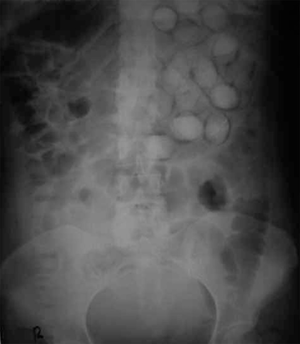We need you! Join our contributor community and become a WikEM editor through our open and transparent promotion process.
Body packing
From WikEM
Contents
Background
- Body packers, also called "mules", swallow or insert drug filled packets into body cavity, usually to smuggle them across borders
- Packets usually made of several layers of latex and outer wax coating
- Each packet contains about 10g of drug and body packers ingest between 50 to 100 drug containers at a time[1]
- Sometimes packets are inserted rectally or vaginally
- Distinct from Body stuffing (ingestion of illicit drugs while pursued by law enforcement, usually small quantity)
Clinical Features
- Situations in which body packers present to the ED:
- Asymptomatic but in custody
- Signs of toxidromes from a ruptured packet
- Signs of bowel obstruction or perforation
Differential Diagnosis
Evaluation
- History and physical
- Type of drug
- Type of packet wrapping (more likely to rupture or leak if home made)
- Number of packets ingested
- GI symptoms (pain, distention, obstipation)
- Other drug use
- Imaging: KUB, CT abdomen pelvis
- Urine drug screen: may be misleading
Management
- Asymptomatic patients
- Expectant management, no surgery, close monitoring in ICU until passage of all packets
- Whole bowel irrigation with polyethylene glycol via NGT at 2L per hour
- Activated charcoal more useful in body stuffers
- Opioid toxicity
- Naloxone: may require very high doses
- 2 to 5mg IV initially, repeat 2mg q5min until responsive
- then total amount required for response should be given every hour as continuous drip
- Naloxone: may require very high doses
- Sympathomimetic toxicity
- Immediate OR for surgical decontamination
- No place for conservative management
- Pharmacologic stabilization appropriate but not definitive, do not delay transfer to the OR
- Hyperthermia
- Active external cooling
- IV benzodiazepines (midazolam 1 to 2mg IV or diazepam 5 to 10 mg IV, rapid escalation in dosing)
- Hypertension
- IV benzodiazepines, phentolamine, nitroprusside, nitroglycerin,, or nicardipine
- Seizures
- IV benzodiazepines, followed by propofol if needed
- Ventricular dysrhythmias
- IV benzodiazepines, followed by hypertonic sodium bicarbonate if wide QRS
- Hyperthermia
- Obstruction or perforation
- OR for immediate ex-lap, then advanced imaging study to document a clear GI tract
- Endoscopic removal highly controversial, risk of packet perforation
Disposition
- Admit all to ICU, regardless of symptoms
- Complete GI decontamination by contrast CT should be documented prior to discharge
- History is unreliable
- Passage of 2 or 3 packet free bowel movements is not sufficient[2]
See Also
External Links
References
- ↑ Booker RJ. Packers, pushers and stuffers--managing patients with concealed drugs in UK emergency departments: a clinical and medicolegal review. Emerg Med J. 2009;26(5):316-20.
- ↑ Rousset P. Detection of residual packets in cocaine body packers: low accuracy of abdominal radiography-a prospective study. Eur Radiol. 2013;23(8):2146-55.
Authors
Lisa Yee, Michael O'Brien, MD, Ross Donaldson, Michael Holtz

